Australia
From jeena
For other uses, see Australia (disambiguation).
| Commonwealth of Australia | ||||||
|---|---|---|---|---|---|---|
| ||||||
| Anthem: "Advance Australia Fair"[N 1] | ||||||
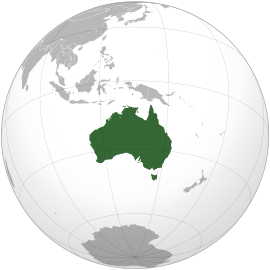 | ||||||
| Capital | Canberra 35°18.48′S 149°7.47′E | |||||
| Largest city | Sydney | |||||
| Official language(s) | None[N 2] | |||||
| National language | English (de facto)[N 2] | |||||
| Demonym | Australian, Aussie[3][4] | |||||
| Government | Federal parliamentaryconstitutional monarchy | |||||
| - | Monarch | Elizabeth II | ||||
| - | Governor-General | Quentin Bryce | ||||
| - | Prime Minister | Julia Gillard | ||||
| Legislature | Parliament | |||||
| - | Upper house | Senate | ||||
| - | Lower house | House of Representatives | ||||
| Independence | from the United Kingdom | |||||
| - | Constitution | 1 January 1901 | ||||
| - | Statute of Westminster | 11 December 1931 | ||||
| - | Statute of Westminster Adoption Act | 9 October 1942 (with effect from 3 September 1939) | ||||
| - | Australia Act | 3 March 1986 | ||||
| Area | ||||||
| - | Total | 7,617,930 km2 (6th) 2,941,299 sq mi | ||||
| Population | ||||||
| - | 2012 estimate | 22,721,644[5] (52nd) | ||||
| - | 2011 census | 21,507,717[6] | ||||
| - | Density | 2.8/km2 (233rd) 7.3/sq mi | ||||
| GDP (PPP) | 2011 estimate | |||||
| - | Total | $914.482 billion[7] (18th) | ||||
| - | Per capita | $40,234[7] (12th) | ||||
| GDP (nominal) | 2011 estimate | |||||
| - | Total | $1.488 trillion[7] (13th) | ||||
| - | Per capita | $65,477[7] (6th) | ||||
| Gini (2006) | 30.5[8] (medium) | |||||
| HDI (2011) | ||||||
| Currency | Australian dollar (AUD) | |||||
| Time zone | various[N 3](UTC+8 to +10.5) | |||||
| - | Summer (DST) | various[N 3] (UTC+8 to +11.5) | ||||
| Date formats | dd-mm-yyyy | |||||
| Drives on the | left | |||||
| ISO 3166 code | AU | |||||
| Internet TLD | .au | |||||
| Calling code | +61 | |||||
Australia ( i/əˈstreɪljə/ ə-strayl-yə [10] or /ɒˈstreɪlɪə/[11] or /ɒˈstreɪljə/ o-strayl-yə), officially the Commonwealth of Australia,[12] is a country in the Southern Hemisphere comprising the mainland of the Australian continent, the island of Tasmania, and numerous smaller islands in the Indian and Pacific Oceans.[N 4] It is the world's sixth-largest country by total area. Neighbouring countries include Indonesia, East Timor and Papua New Guinea to the north; theSolomon Islands, Vanuatu and New Caledonia to the north-east; and New Zealand to the south-east.
i/əˈstreɪljə/ ə-strayl-yə [10] or /ɒˈstreɪlɪə/[11] or /ɒˈstreɪljə/ o-strayl-yə), officially the Commonwealth of Australia,[12] is a country in the Southern Hemisphere comprising the mainland of the Australian continent, the island of Tasmania, and numerous smaller islands in the Indian and Pacific Oceans.[N 4] It is the world's sixth-largest country by total area. Neighbouring countries include Indonesia, East Timor and Papua New Guinea to the north; theSolomon Islands, Vanuatu and New Caledonia to the north-east; and New Zealand to the south-east.
For at least 40,000 years[14] before European settlement in the late 18th century, Australia was inhabited by indigenous Australians,[15] who belonged to one or more of roughly 250 language groups.[16][17] After discovery by Dutch explorers in 1606, Australia's eastern half was claimed by Great Britain in 1770 and settled through penal transportation to the colony of New South Wales from 26 January 1788. The population grew steadily in subsequent decades; the continent was explored and an additional five self-governing Crown Colonies were established.
On 1 January 1901, the six colonies federated, forming the Commonwealth of Australia. Since Federation, Australia has maintained a stable liberal democratic political system that functions as a federal parliamentary democracy andconstitutional monarchy. The federation comprises six states and several territories. The population of 22.7 million [5] is heavily concentrated in the Eastern states and is highly urbanised.
A highly developed country, Australia is the world's 13th-largest economy and has the world's sixth-highest per capita income. Australia's military expenditure is the world's 13th-largest. With the second-highest human development index globally, Australia ranks highly in many international comparisons of national performance, such as quality of life, health, education, economic freedom, and the protection of civil liberties and political rights.[18] Australia is a member of theG20, OECD, WTO, APEC, UN, Commonwealth of Nations, ANZUS, and the Pacific Islands Forum.
Contents[hide]
|
Etymology
Pronounced [əˈstɹæɪljə, -liə] in Australian English,[19] the name Australia is derived from the Latin australis, meaning "southern". The country has been referred to colloquially as Oz since the early 20th century.[N 5] Aussie is a common colloquial term for "Australian". In neighbouring New Zealand the term "Aussie" is sometimes applied as a noun to the nation as well as its residents.[24]
Legends of Terra Australis Incognita—an "unknown land of the South"—date back to Roman times and were commonplace in medieval geography, although not based on any documented knowledge of the continent. Following European discovery, names for the Australian landmass were often references to the famed Terra Australis.
The earliest recorded use of the word Australia in English was in 1625 in "A note of Australia del Espíritu Santo, written by Sir Richard Hakluyt", published by Samuel Purchas in Hakluytus Posthumus, a corruption of the original Spanish name "Tierra Austral del Espíritu Santo" (Southern Land of the Holy Spirit)[25] for an island in Vanuatu.[26] The Dutch adjectival form Australische was used in a Dutch book in Batavia (Jakarta) in 1638, to refer to the newly discovered lands to the south.[27] Australia was later used in a 1693 translation of Les Aventures de Jacques Sadeur dans la Découverte et le Voyage de la Terre Australe, a 1676 French novel by Gabriel de Foigny, under the pen-name Jacques Sadeur.[28] Referring to the entire South Pacific region, Alexander Dalrymple used it in An Historical Collection of Voyages and Discoveries in the South Pacific Ocean in 1771. By the end of the 18th century, the name was being used to refer specifically to Australia, with the botanists George Shaw and Sir James Smith writing of "the vast island, or rather continent, of Australia, Australasia or New Holland" in their 1793 Zoology and Botany of New Holland,[29] and James Wilson including it on a 1799 chart.[30]
The name Australia was popularised by the explorer Matthew Flinders, who pushed for it to be formally adopted as early as 1804. When preparing his manuscript and charts for his 1814 A Voyage to Terra Australis, he was persuaded by his patron, Sir Joseph Banks, to use the term Terra Australis as this was the name most familiar to the public. Flinders did so, but allowed himself the footnote:
"Had I permitted myself any innovation on the original term, it would have been to convert it to Australia; as being more agreeable to the ear, and an assimilation to the names of the other great portions of the earth."[31]
This is the only occurrence of the word Australia in that text; but in Appendix III, Robert Brown's General remarks, geographical and systematical, on the botany of Terra Australis, Brown makes use of the adjectival form Australianthroughout,[32]—the first known use of that form.[33] Despite popular conception, the book was not instrumental in the adoption of the name: the name came gradually to be accepted over the following ten years.[34]
The first time that the name Australia appears to have been officially used was in a despatch to Lord Bathurst of 4 April 1817 in which Governor Lachlan Macquarie acknowledges the receipt of Capt. Flinders' charts of Australia.[35] On 12 December 1817 Macquarie recommended to the Colonial Office that it be formally adopted.[36] In 1824, the Admiralty agreed that the continent should be known officially as Australia.[37]
The first map on which the word Australia occurs was published in St Petersburg in 1824. It is in Krusenstern's "Atlas de l'Océan Pacifique".[38]
History
Main article: History of Australia
Human habitation of the Australian continent is estimated to have begun between 42,000 and 48,000 years ago,[39] possibly with the migration of people by land bridges and short sea-crossings from what is now South-East Asia. These first inhabitants may have been ancestors of modern Indigenous Australians.[40] At the time of European settlement in the late 18th century, most Indigenous Australians were hunter-gatherers, with a complex oral culture and spiritual values based on reverence for the land and a belief in the Dreamtime. The Torres Strait Islanders, ethnically Melanesian, were originally horticulturalists and hunter-gatherers.[41]
Following sporadic visits by fishermen from Maritime Southeast Asia,[42] the first recorded European sighting of the Australian mainland, and the first recorded European landfall on the Australian continent, are attributed to the Dutch navigatorWillem Janszoon. He sighted the coast of Cape York Peninsula in early 1606, and made landfall on 26 February at the Pennefather River near the modern town of Weipa on Cape York.[43] The Dutch charted the whole of the western and northern coastlines of "New Holland" during the 17th century, but made no attempt at settlement.[43] William Dampier, an English explorer and privateer, landed on the north-west coast of Australia in 1688 and again in 1699 on a return trip. In 1770, James Cook sailed along and mapped the east coast of Australia, which he named New South Wales and claimed for Great Britain.[44] Cook's discoveries prepared the way for establishment of a new penal colony. Captain Arthur Phillip led the First Fleet into Port Jackson on 26 January 1788.[45] This date became Australia's national day, Australia Day although the British Crown Colony of New South Wales was not formally promulgated until 7 February 1788. Van Diemen's Land, now known as Tasmania, was settled in 1803 and became a separate colony in 1825.[46] The United Kingdom formally claimed the western part of Western Australia (the Swan River Colony) in 1828.[47]
Separate colonies were carved from parts of New South Wales: South Australia in 1836, Victoria in 1851, and Queensland in 1859.[48] The Northern Territory was founded in 1911 when it was excised from South Australia.[49] South Australia was founded as a "free province"—it was never a penal colony.[50] Victoria and Western Australia were also founded "free", but later accepted transported convicts.[51][52] A campaign by the settlers of New South Wales led to the end of convict transportation to that colony; the last convict ship arrived in 1848.[53]
The indigenous population, estimated at 750,000 to 1,000,000 at the time of European settlement,[54] declined for 150 years following settlement, mainly due to infectious disease.[55] The "Stolen Generations" (removal of Aboriginal children from their families), which historians such as Henry Reynolds have argued could be considered genocide,[56] may have contributed to the decline in the Indigenous population.[57] Such interpretations of Aboriginal history are disputed by conservative commentators as exaggerated or fabricated for political or ideological reasons.[58] This debate is known within Australia as the History wars.[59] The Federal government gained the power to make laws with respect to Aborigines following the 1967 referendum.[60]Traditional ownership of land—aboriginal title—was not recognised until 1992, when the High Court case Mabo v Queensland (No 2) overturned the notion of Australia as terra nullius ("land belonging to no one") before European occupation.[61]
A gold rush began in Australia in the early 1850s,[62] and the Eureka Rebellion against mining licence fees in 1854 was an early expression of civil disobedience.[63] Between 1855 and 1890, the six colonies individually gainedresponsible government, managing most of their own affairs while remaining part of the British Empire.[64] The Colonial Office in London retained control of some matters, notably foreign affairs,[65] defence,[66] and international shipping.
On 1 January 1901, federation of the colonies was achieved after a decade of planning, consultation, and voting.[67] The Commonwealth of Australia was established and it became a dominionof the British Empire in 1907. The Federal Capital Territory (later renamed the Australian Capital Territory) was formed in 1911 as the location for the future federal capital of Canberra. Melbourne was the temporary seat of government from 1901 to 1927 while Canberra was constructed.[68] The Northern Territory was transferred from the control of the South Australian government to the federal parliament in 1911.[69] In 1914, Australia joined Britain in fighting World War I, with support from both the outgoing Commonwealth Liberal Party and the incomingAustralian Labor Party.[70] Australians took part in many of the major battles fought on the Western Front.[71] Of about 416,000 who served, about 60,000 were killed and another 152,000 were wounded.[72] Many Australians regard the defeat of the Australian and New Zealand Army Corps (ANZACs) at Gallipoli as the birth of the nation—its first major military action.[73][74] TheKokoda Track campaign is regarded by many as an analogous nation-defining event during World War II.[75]
Britain's Statute of Westminster 1931 formally ended most of the constitutional links between Australia and the UK. Australia adopted it in 1942,[76] but it was backdated to 1939 to confirm the validity of legislation passed by the Australian Parliament during World War II.[77][78] The shock of the United Kingdom's defeat in Asia in 1942 and the threat of Japanese invasion caused Australia to turn to the United States as a new ally and protector.[79] Since 1951, Australia has been a formal military ally of the US, under the ANZUS treaty.[80] After World War II Australia encouraged immigration from Europe. Since the 1970s and following the abolition of the White Australia policy, immigration from Asia and elsewhere was also promoted.[81] As a result, Australia's demography, culture, and self-image were transformed.[82] The final constitutional ties between Australia and the UK were severed with the passing of the Australia Act 1986, ending any British role in the government of the Australian States, and closing the option of judicial appeals to the Privy Council in London.[83] In a 1999 referendum, 55 per cent of voters and a majority in every state rejected a proposal to become arepublic with a president appointed by a two-thirds vote in both Houses of the Australian Parliament. Since the election of the Whitlam Government in 1972,[84] there has been an increasing focus in foreign policy on ties with other Pacific Rim nations, while maintaining close ties with Australia's traditional allies and trading partners.[85]
Government
Main articles: Government of Australia, Politics of Australia, and Monarchy of Australia
Australia is a constitutional monarchy with a federal division of powers. It uses a parliamentary system of government with Queen Elizabeth II at its apex as the Queen of Australia, a role that is distinct from her position as monarch of the otherCommonwealth realms. The Queen resides in the United Kingdom, and she is represented by her viceroys in Australia (the Governor-General at the federal level and by the Governors at the state level), who by convention act on the advice of her ministers. Supreme executive authority is vested by the Constitution of Australia in the sovereign, but the power to exercise it is conferred by the Constitution specifically to the Governor-General.[86][87] The most notable exercise of the Governor-General's reserve powers outside a Prime Minister's request was the dismissal of the Whitlam Government in the constitutional crisis of 1975.[88]
The federal government is separated into three branches:
- The legislature: the bicameral Parliament, defined in section 1 of the constitution as comprising the Queen (represented by the Governor-General), the Senate, and the House of Representatives;
- The executive: the Federal Executive Council, in practice the Governor-General as advised by the Prime Minister and Ministers of State;[89]
- The judiciary: the High Court of Australia and other federal courts, whose judges are appointed by the Governor-General on advice of the Council.
In the Senate (the upper house), there are 76 senators: twelve each from the states and two each from the mainland territories (the Australian Capital Territory and the Northern Territory).[90] The House of Representatives (the lower house) has 150 members elected from single-member electoral divisions, commonly known as "electorates" or "seats", allocated to states on the basis of population,[91] with each original state guaranteed a minimum of five seats.[92] Elections for both chambers are normally held every three years, simultaneously; senators have overlapping six-year terms except for those from the territories, whose terms are not fixed but are tied to the electoral cycle for the lower house; thus only 40 of the 76 places in the Senate are put to each election unless the cycle is interrupted by a double dissolution.[90]
Australia's electoral system uses preferential voting for all lower house elections with the exception of Tasmania and the ACT, which, along with the Senate and most state upper houses, combine it with proportional representation in a system known as the single transferable vote. Voting is compulsory for all enrolled citizens 18 years and over in every jurisdiction,[93] as is enrolment (with the exception of South Australia).[94] The party with majority support in the House of Representatives forms the government and its leader becomes Prime Minister. In cases where no party has majority support, the Governor-General has the power to appoint the Prime Minister, and if necessary dismiss one that has lost the confidence of Parliament.[95]
There are two major political groups that usually form government, federally and in the states: the Australian Labor Party, and the Coalition which is a formal grouping of the Liberal Party and its minor partner, the National Party.[96][97] Independent members and several minor parties have achieved representation in Australian parliaments, mostly in upper houses.
Within Australian political culture, the Coalition is considered centre-right and the Labor Party is considered centre-left. Queensland in particular, along with Western Australia and the Northern Territory, are regarded as comparativelyconservative.[98][99][100][101][102][103] Victoria, South Australia, Tasmania, and the Australian Capital Territory are regarded as comparatively socially liberal.[103][104][105][106] New South Wales has often been regarded as a politically moderatebellwether state.[103][106]
Following a partyroom leadership challenge, Julia Gillard became the first female Prime Minister in June 2010.[107] The most recent federal election was held on 21 August 2010 and resulted in the first hung parliament in over 50 years. Gillard was able to form a minority Labor government with the support of independents.
States and territories
Main article: States and territories of Australia
Australia has six states—New South Wales, Queensland, South Australia, Tasmania, Victoria, and Western Australia—and two major mainland territories—the Northern Territory and the Australian Capital Territory (ACT). In most respects these two territories function as states, but the Commonwealth Parliament can override any legislation of their parliaments. By contrast, federal legislation overrides state legislation only in areas that are set out in Section 51 of the Australian Constitution; state parliaments retain all residual legislative powers, including those over schools, state police, the state judiciary, roads, public transport, and local government, since these do not fall under the provisions listed in Section 51.[108]
Each state and major mainland territory has its own parliament—unicameral in the Northern Territory, the ACT, and Queensland, and bicameral in the other states. The states are sovereign entities, although subject to certain powers of the Commonwealth as defined by the Constitution. The lower houses are known as the Legislative Assembly (the House of Assembly in South Australia and Tasmania); the upper houses are known as the Legislative Council. The head of the governmentin each state is the Premier, and in each territory the Chief Minister. The Queen is represented in each state by a Governor; and in the Northern Territory, the Administrator.[109] In the Commonwealth, the Queen's representative is the Governor-General.[110]
The federal parliament directly administers the following territories:[89]
- Ashmore and Cartier Islands
- Australian Antarctic Territory
- Christmas Island and Cocos (Keeling) Islands
- Coral Sea Islands
- Heard Island and McDonald Islands
- Jervis Bay Territory, a naval base and sea port for the national capital in land that was formerly part of New South Wales
Norfolk Island is also technically an external territory; however, under the Norfolk Island Act 1979 it has been granted more autonomy and is governed locally by its own legislative assembly. The Queen is represented by anAdministrator, currently Owen Walsh.[111]
Foreign relations and military
Main articles: Foreign relations of Australia and Australian Defence Force
Over recent decades, Australia's foreign relations have been driven by a close association with the United States through the ANZUS pact, and by a desire to develop relationships with Asia and the Pacific, particularly throughASEAN and the Pacific Islands Forum. In 2005 Australia secured an inaugural seat at the East Asia Summit following its accession to the Treaty of Amity and Cooperation in Southeast Asia, and in 2011 attended the Sixth East Asia Summit in Indonesia. Australia is a member of the Commonwealth of Nations, in which the Commonwealth Heads of Government meetings provide the main forum for co-operation.[112]
Australia has pursued the cause of international trade liberalisation.[113][114][115] It led the formation of the Cairns Group and Asia-Pacific Economic Cooperation.[116][117] Australia is a member of the Organisation for Economic Co-operation and Development and the World Trade Organization,[118][119] and has pursued several major bilateral free trade agreements, most recently the Australia – United States Free Trade Agreement[120] and Closer Economic Relations with New Zealand,[121] with another free trade agreement being negotiated with China—the Australia–China Free Trade Agreement—and Japan,[122] South Korea in 2011,[123][124] Australia–Chile Free Trade Agreement, ASEAN – Australia – New Zealand Free Trade Area, and the Trans-Pacific Strategic Economic Partnership.
Along with New Zealand, the United Kingdom, Malaysia and Singapore, Australia is party to the Five Power Defence Arrangements, a regional defence agreement. A founding member country of the United Nations, Australia is strongly committed to multilateralism[125] and maintains an international aid program under which some 60 countries receive assistance. The 2005–06 budget provides A$2.5 billion for development assistance.[126] Australia ranks seventh overall in the Center for Global Development's 2008 Commitment to Development Index.[127]
Australia's armed forces—the Australian Defence Force (ADF)—comprise the Royal Australian Navy (RAN), the Australian Army and the Royal Australian Air Force (RAAF), in total numbering 80,561 personnel (including 55,068 regulars and 25,493 reservists).[128] The titular role of Commander-in-Chief is vested in the Governor-General, who appoints a Chief of the Defence Force from one of the armed services on the advice of the government.[129] Day-to-day force operations are under the command of the Chief, while broader administration and the formulation of defence policy is undertaken by the Minister and Department of Defence.
In the 2010–11 budget, defence spending was A$25.7 billion,[130] representing the 13th largest defence budget.[131] Australia has been involved in UN and regional peacekeeping, disaster relief and armed conflict; it currently has deployedapproximately 3,330 defence force personnel in varying capacities to 12 international operations in areas including East Timor, Solomon Islands and Afghanistan.





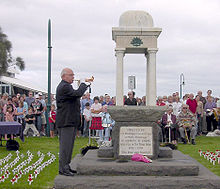

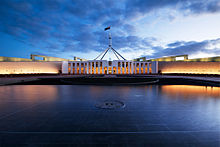
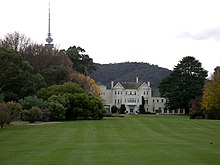

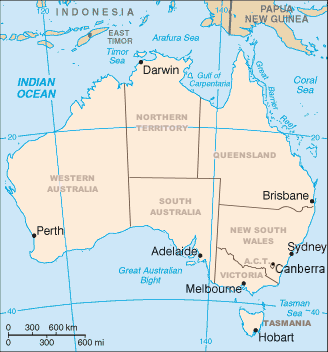

No comments:
Post a Comment